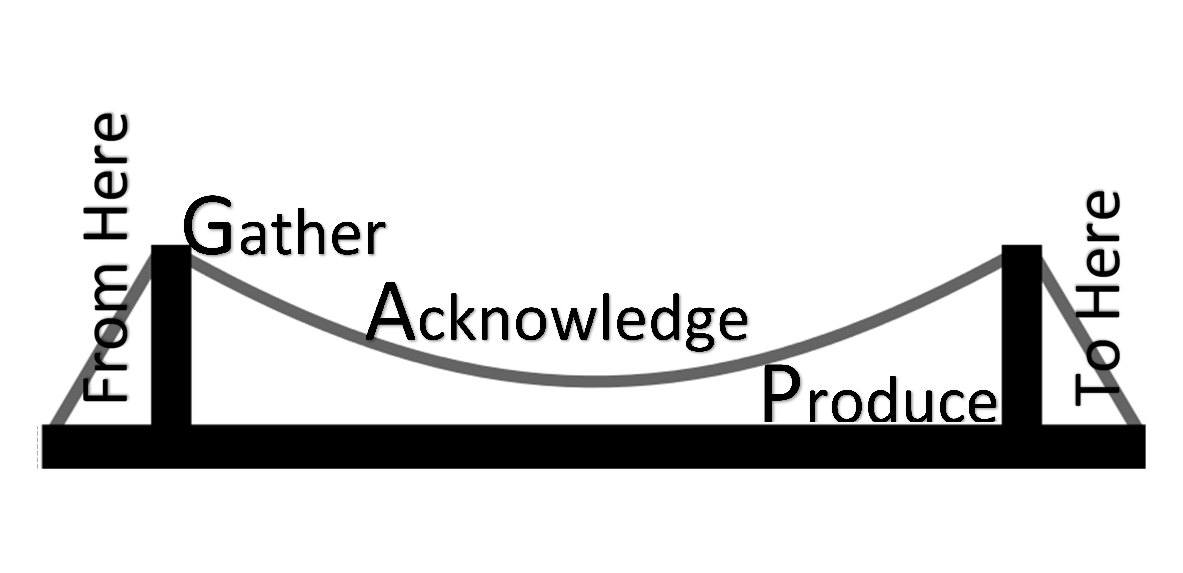A Coaching Model Created by Ann Marie Donlin
(Life Coach/Mentor Coach, UNITED STATES)
Moving Clients from where they are to where they want to be.
Your problem is to bridge the gap which exists between where you are now and the goal you intend to reach. ~Earl Nightingale
Bridging the GAP requires change
Only I can change my life. No one can do it for me.~Carol Burnet
Carol Burnet is right. Changes in our lives can only be accomplished by ourselves. Support in making these accomplishments reality come from a coach.
In a client’s life, change is made by the client. A coach however, can support the client in a way that assures the change created will make a difference for the client.
Bridging the GAP Coaching Model assists the client in changing the current projection of their lives by looking at and changing three areas.
Through this Model, the client takes one change at a time, one goal at a time to master change.
All action results from thought, so it is thoughts that matter.~Sai Baba
Gather information about current perspectives, thoughts, and underlying beliefs. A client’s perspectives, thoughts and underlying beliefs make up where they currently are, in their work lives or personal lives.
- What is important about this for you?
- What do you need to do about this is now?
- What will happen if you do?
- don’t?
- What will make this a priority for you?
- How do you explain this to yourself?
- How do you suppose you could improve this situation?
- What are you willing to do differently?
- What might you be connected to that keeps you here?
With this knowledge, the client can now understand what effect the perspectives, thoughts, and underlying beliefs they hold are having on the ideas about what they want to do. They can now work on what needs to change.
You can’t change what you don’t acknowledge. ~Phillip C. McGraw
Acknowledge which perspectives, thoughts, and underlying beliefs need to change. In doing this the client can see more clearly what may be holding them back and keeping them from moving in the direction they want.
- Are there any patterns you can sense or see around this?
- Are your thoughts helping or hurting?
- What new choices do you see?
- How can you use the new choices you see?
Acknowledging those items that hold clients back can be a difficult task. Some of these perspectives, thoughts, and underlying beliefs have dwelled within our clients for a long time. This does not, by any means, suggest they are permanent. Everyone has the power to make a change. Occasionally this action may take several sessions before true change can be made. The client needs to be sure of the changes they would like to make.
Structure is not just a means to a solution. It is also a principle and a passion.~Marcel Breuer
Produce structures to support change in the perspectives, thoughts, and underlying beliefs. Once the client has identified what needs to change, they can begin to work through building structures to support the change they seek.
- In what way is the current situation perfect?
- What are you doing well?
- What can you change to create better outcomes?
- What’s missing here, that if included, will make a difference?
- What if anything, is in your current situation that maybe keeping you from the change you want to make?
- What needs to change to reach this goal?
AND
- Are there any thoughts you could use to replace the current thought?
- What support does this goal need to make it a reality?
- What things can you bring into your daily life that will support this change?
- What is supporting you now, and how can you strengthen these supports?
Producing structures to support change can be the most enjoyable part of the process. When a client begins to create their own structures to support their dreams amazing things begin to happen. The clarity and progress moves quickly.
References
Quotes found on Brain Quotes (www.brainyquote.com), AZ Quotes (www.azquotes.com) and Quote Fancy (www.quotefancy.com)
Creating Structures, © International Coach Academy 2015 www.icacoach.com
